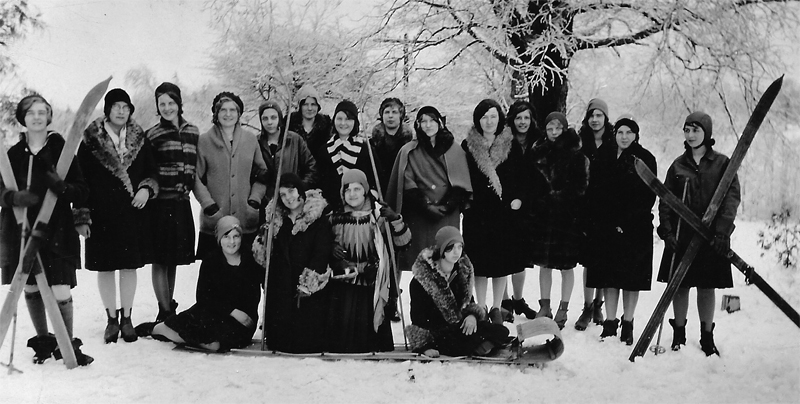
Notre Dame Academy senior students enjoying winter outdoors (1930).
A starlit sky above the new Canadian Motherhouse brightened the arrival of three sisters, 10 candidates and 22 aspirants and boarders. It was 5 p.m. on February 14, 1927, when the train from Kitchener, Ontario, stopped at the Waterdown station.
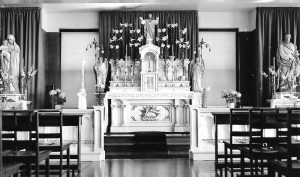
Chapel (1927 -1956)
Cars were waiting to drive the new arrivals to 1921 Snake Road. The statue of Our Lady of Grace, aglow with light high above the front balcony, was there with arms extended in welcome. At the front entrance stood the smiling Mother Baptist Klein, Sisters Othwina Tiefenbrun, Hilda Lienhardt, Humberta Schmitz and Pontia Diebolt. The group was led to the chapel where the first community sang, “Holy God We Praise Thy Name.”
In March 1926, Mother Stanislaus Koska Schilling, commissary general in North America, wrote, “for some time we have been considering forming a Canadian province. The growth of the order in Canada warrants this.” Also of note, the provincial superior in Milwaukee felt that she really did not know the sisters missioned in Canada since she had limited personal contact with them. There were 19 missions in Ontario with 123 sisters, 67 of whom were Canadian and 56 from the United States or Germany.
Land was purchased for the motherhouse within the picturesque Niagara escarpment and near to Hamilton Teachers’ College. Mother Baptist and Sister Othwina were given charge of overseeing the construction.
The new motherhouse was home to the newly elected provincial council, young women in formation, sisters attending Hamilton Teachers’ College and those who taught in schools in Hamilton. The bus which took the sisters to the various schools each morning returned with day students who attended Notre Dame Academy. Attractive bedrooms accommodated 40 boarders from nearby cities and various countries. Local children attended elementary classes until St. Thomas School opened in 1951.
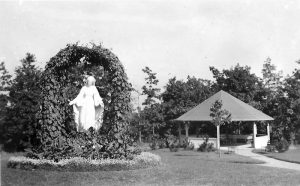
Statue of Mary. Pavilion in the background (1935).
196 acres of farm, forest, orchards
The original site consisted of 196 acres of farm land, woodland, and orchards. Until the late 1950’s, the farm, vegetable gardens and a variety of fruit trees provided for the needs of the sisters and boarders. Adjacent to the convent was the powerhouse which contained the heating plant and large laundry. At the rear of the building, a road still leads to the cemetery where more than 290 sisters are buried.
On the east side of the convent is a path leading to a statue of the Blessed Virgin Mary. Further on the path is the pavilion. Behind it is a gully which leads to the beautiful Waterdown Falls. In the early years hiking down the gully was a favorite activity.
Annual retreats were held for the sisters. From 1930 to the early 1950’s, diocesan priests chose to have their retreats at the motherhouse.
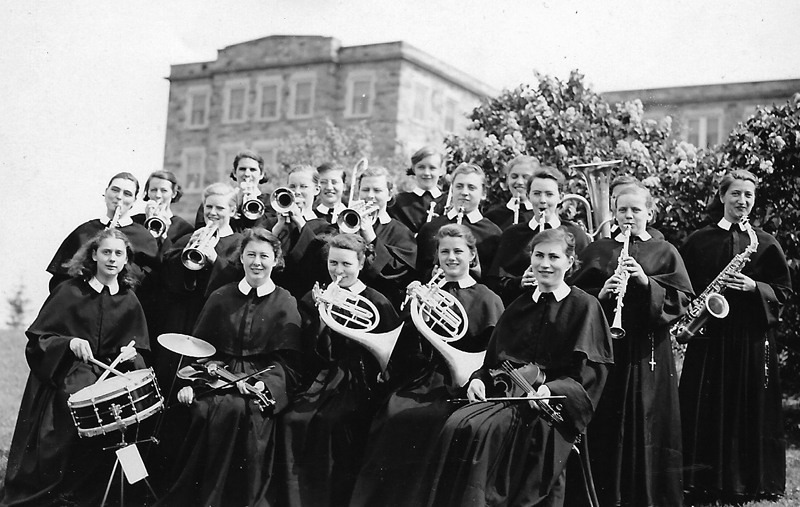
Candidates’ Band Practice (1941)
In 1956, a chapel was erected at the rear of the building. It was constructed of entirely Canadian materials – wood, marble and stone. Beneath the chapel was a spacious gym with a large stage which was particularly useful to academy students.
In 1964, the Villa wing was added on the west side. The third floor was an infirmary for the sick and elderly. Individual bedrooms were on the second and fourth floors. A bowling alley in the basement was a popular place for sisters and students.
Academy building transitions to new uses
The much loved Notre Dame Academy closed its doors to boarding and day students in June 1983. The following year, the academy area became the Notre Dame Centre which offered accommodation for conferences, workshops and retreats. These groups facilitated their own programs.
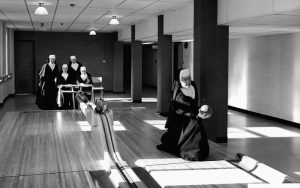
Bowling Alley (1965)
In 1988, Children’s Workshop rented a room for pre-schoolers. Montessori set up classes in 1990, and in 2000 a pre-fabricated school was built on the former baseball diamond. In April 1993, Seniors Activation Maintenance (S.A.M.) program brought in seniors for daytime enrichment and activities. Both the Montessori School and S.A.M. continue to operate on the premises today.
By the mid-1990s, the Notre Dame Centre was not being used to full capacity. The Villa wing with the infirmary and the rooms for senior sisters no longer seemed adequate. With an increasing number of sisters retiring, it became apparent that a home for senior sisters was needed.
A home for senior sisters
After much consultation and dialogue, it was determined that the motherhouse would be renovated into a home for senior sisters. The solid structure of the original building proved to be preferable for renovations rather than the 1964 Villa wing. Renovations began in March 1997 and continued through to July 1998.
The third floor is a state-of-the art healthcare facility with additional services to those on the fourth floor. The Villa wing was razed in 1999 and replaced by the beautiful Jubilee Garden in 2000. The Bruce Trail, Canada’s oldest and longest trail from Niagara to Tobermory, is at the south end of the property. In 2006, part of the land in the ravine east of the Bruce Trail was sold to the Bruce Trail Conservancy.
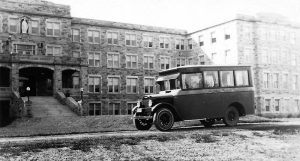
Bus transporting sisters to schools in Hamilton and returning with students for Notre Dame Academy (1928)
Although Notre Dame Convent commands a view of the waters of Lake Ontario and a panoramic view of the city of Hamilton, Burlington Bay and the Niagara Escarpment, it most importantly continues to be a home – a home to vowed religious who in their senior years live in a prayerful atmosphere. In earlier years it was a home for young women who were in their formative years becoming School Sisters of Notre Dame. Through the years, it was a home to students of Notre Dame Academy. Countless girls attribute their years at NDA as being their most influential years, giving them a sense of stability and security, and imparting a life of faith.
On July 14, 2012, the Canadian province, in its 85th year as a province, integrated with the Atlantic-Midwest province.
– By Sister Joan Helm, SSND
